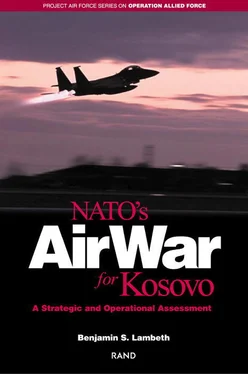NATO’s final plan was conceived from the start as a coercive operation only, with the implied goal of inflicting merely enough pain to persuade Milosevic to capitulate. Its first phase, against only 51 approved integrated air defense system (IADS) targets and 40 approved punishment targets out of 169 in NATO’s Master Target File, entailed attacks against a combination of enemy air defenses and fixed army installations that aimed at softening up Yugoslavia’s IADS and demonstrating NATO’s ability to conduct precise air attacks with a minimum of unintended damage. The second phase envisaged attacks against military targets mainly, though not exclusively, below the 44th parallel, which bisected Yugoslavia well south of Belgrade (see Figure 2.1). Only in the third phase, if need be, would the bombing go in earnest after military facilities north of the 44th parallel and against targets in Belgrade itself. [13]NATO had approved this three-phase plan in principle the preceding October as a part of its ACTORD and had handed the keys for Phase I to Solana on January 30. Approval by the NAC of Phases II and III, however, would come only after the air effort began.
Figure 2.1—Allied Force Area of Operations
For his part, General Clark had called for punitive air strikes against Yugoslavia as early as January 1999, in response to the Serb massacre of 45 Kosovar Albanians near the town of Racak just days before. Persistent pressures from within NATO to explore a diplomatic solution, however, outweighed that recommendation for the early use of force. The resulting delay gave Milosevic time to bolster his forces, disperse important military assets, hunker down for an eventual bombing campaign, and lay the final groundwork for the ethnic cleansing of Kosovo. Owing to that delay, NATO lost any element of surprise that may otherwise have been available. [14]
In the end, Operation Allied Force came just 10 days short of NATO’s 50th anniversary. The Clinton administration did not seek a UN Security Council resolution approving the air attack plan, since it knew that Russia and China had both vowed to veto any proposal calling for air strikes. [15]NATO’s going-in expectation was that the bombing would be over very quickly. Indeed, so confident were its principals that merely a token bombing effort would suffice to persuade Milosevic to yield that the initial attack was openly announced in advance, with U.S. officials conceding up front that it would take a day or more to program all of the TLAMs to hit some 60 planned aim points. [16]Only at the last minute did NATO’s political leaders give Secretary General Solana authority for what one NATO official called a “much more diverse target list, a more intensive pace of operations, and an expanded geographical zone.” [17]Once under way, the slowly escalating air effort put the United States into two simultaneous regional conflicts (the other being Operations Northern and Southern Watch against Iraq) for the first time since World War II. It also made for a uniquely demanding test for American air power and became the most serious foreign policy crisis of the Clinton presidency.
Chapter Three
THE AIR WAR UNFOLDS
The operational setting of Yugoslavia contrasted sharply with the one presented to coalition planners by Iraq in 1991. Defined by a series of interwoven valleys partly surrounded by mountains and protected by low cloud cover and fog, Serbia and Kosovo made up an arena smaller than the state of Kentucky (39,000 square miles), with Kosovo itself no larger than the Los Angeles metropolitan area. Its topography and weather—compounded by an enemy IADS that was guaranteed to make offensive operations both difficult and dangerous—promised to provide a unique challenge for NATO air power.
Yugoslavia’s air defenses were dominated by surface-to-air missile (SAM) batteries equipped with thousands of Soviet-made SAMs, including three SA-2 battalions; 16 SA-3 battalions, each with numerous launchers directed by LOW BLOW fire-control radars; and five SA-6 regiments fielding five batteries each, for a total of 25 SA-6 batteries directed by STRAIGHT FLUSH radars. These radar-guided SAMs were supplemented by around 100 vehicle-mounted SA-9 and several SA-13 infrared SAMs, along with a profusion of man-portable infrared SAMs, some 1,850 antiaircraft artillery (AAA) pieces, and numerous stockpiled reserve weapons and buried communications lines. Backing up these defenses, the Yugoslav air force consisted of 238 combat aircraft, including 15 MiG-29 and 64 MiG-21 fighter-interceptors. [1]Although the Yugoslav IADS employed equipment and technologies that dated as far back as the 1960s, albeit presumably with selected upgrades, its operators knew U.S. tactics well and had practiced air defense drills and honed their operational techniques for more than four decades. They also had the benefit of more equipment and better training than did the Bosnian Serbs in 1995. Finally, they enjoyed the advantage of being protected both by mountainous terrain and by the cover of inclement weather when the air war began.
In addition, Serbia’s SA-2s, SA-3s, and SA-6s were served by more than 100 acquisition and tracking radars, all of which were internetted by underground land lines and fiber optic cables. They were further backstopped by a robust civilian and military visual observer network that included covert Serb observers who monitored NATO aircraft as they took off from their bases in Europe. [2]In anticipation of a possible air offensive, Yugoslav defense specialists had met the month before in Baghdad with their Iraqi counterparts. Indeed, such Yugoslav-Iraqi collaboration had long preceded the Kosovo crisis. Baghdad had purchased some Yugoslav IADS equipment late during the cold war before the onset of Desert Storm. Iraq also very likely shared intelligence with Belgrade on U.S. suppression of enemy air defenses (SEAD) tactics, as well as its own experience and recommendations, in subsequent years. [3]According to General Salko Begic, the air commander for the Muslim-Croat federation in Bosnia and a former service academy classmate of the Serb generals who were running Yugoslavia’s air defenses when the air attacks began, the intended tactic to be used against attacking NATO aircraft was to create a killing zone below 10,000 ft by means of AAA, SA-7 infrared SAMs, and Swedish Bofors man-portable air defenses. [4]
In commenting on this layered and redundant air defense net, USAF chief of staff General Michael Ryan, who earlier had commanded Operation Deliberate Force over Bosnia in 1995, frankly conceded in congressional testimony before the start of the operation that “these guys are very good” and that friendly aircraft and aircrew losses were “a distinct possibility.” [5]Ryan added that Yugoslavia’s IADS made for a “very substantive air defense capability” and that the Serbs maintained a “very professional army and air defense corps.” Because of the assessed robustness of the Yugoslav IADS, Pentagon planners were said to have estimated before opening night that NATO could lose as many as 10 aircraft in the initial wave of strikes. [6]
INITIAL ATTACKS AND THEIR EFFECTS
Operation Allied Force began against Yugoslavia on the night of March 24, within minutes of President Clinton’s announcement that air attacks were under way. The initial concept of operations envisaged night raids against so-called enabling targets, such as enemy air defense assets, in order to create a more permissive operating environment for subsequent attacks against other classes of targets. In announcing the commencement of attacks, the president declared that the operation had three goals: “To demonstrate the seriousness of NATO’s opposition to aggression,” to deter Milosevic from “continuing and escalating his attacks on helpless civilians,” and, if need be, “to damage Serbia’s capacity to wage war against Kosovo by seriously diminishing its military capabilities.” At the same time, he pointedly stressed: “I don’t intend to put our troops in Kosovo to fight a war.” [7]To those opening words, the chairman of the Joint Chiefs of Staff, U.S. Army General Henry H. Shelton, added that NATO would engage “the full range of his military capabilities” if Milosevic did not desist from his offensive in Kosovo. [8]As noted earlier, it was accepted as a given by the Clinton administration that Milosevic would settle quickly. As Secretary of State Albright clearly attested to this expectation in a television interview on the evening that the air attacks began: “I don’t see this as a long-term operation.” [9]
Читать дальше












